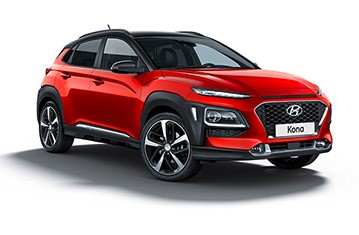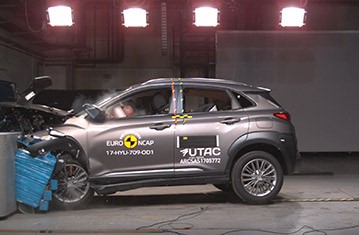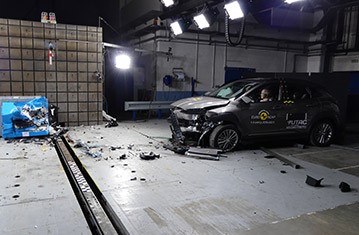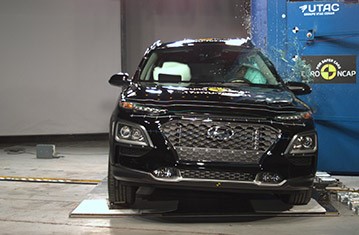- With standard equipment
- With safety pack
Find more information in the General Comments section of the assessment
Find more information in the Rating Validity tab of the assessment
- See More
- See More
- See More
- See More
- Good
- Adequate
- Marginal
- Weak
- Poor
 Passenger
Passenger
 Driver
Driver
 Rear Passenger
Rear Passenger
 Driver
Driver
 Car
Car
 Pole
Pole
 Rear Seat
Rear Seat
 Front Seat
Front Seat
- Good
- Adequate
- Marginal
- Weak
- Poor


Passenger
outboard
center
Fitted to the vehicle as standard
Not fitted to the test vehicle but available as option
Not Available
-
i-Size CRS
-
ISOFIX CRS
-
Universal Belted CRS
Easy
Difficult
Safety critical
Not allowed
| Seat Position | ||||
|---|---|---|---|---|
| Front | 2nd row | |||
| Passenger | Left | center | Right | |
| Maxi Cosi 2way Pearl & 2wayFix (rearward) (iSize) | ||||
| Maxi Cosi 2way Pearl & 2wayFix (forward) (iSize) | ||||
| BeSafe iZi Kid X2 i-Size (iSize) | ||||
| Maxi Cosi Cabriofix & FamilyFix (ISOFIX) | ||||
| BeSafe iZi Kid X4 ISOfix (ISOFIX) | ||||
| Britax Römer Duo Plus (ISOFIX) | ||||
| Britax Römer KidFix XP (ISOFIX) | ||||
| Maxi Cosi Cabriofix (Belt) | ||||
| Maxi Cosi Cabriofix & EasyBase2 (Belt) | ||||
| Britax Römer King II LS (Belt) | ||||
| Britax Römer KidFix XP (Belt) | ||||
Easy
Difficult
Safety critical
Not allowed
In the frontal offset test, protection of both dummies was good or adequate for all critical body areas. In the side barrier test, the head of the 10 year dummy 'bottomed out' the curtain airbag but dummy readings indicated adequate protection for this part of the body. Otherwise, protection of both child dummies was good. The front passenger airbag can be disabled to allow a rearward-facing child restraint to be used in that seating position. Clear information is provided to the driver regarding the status of the airbag and the system was rewarded. The rear centre seating position failed the installation test for two belted universal restraints, owing to interference between the restraint and the buckle. Otherwise, restraints could be properly installed and accommodated in the car.
- Good
- Adequate
- Marginal
- Weak
- Poor

Head Impact 14.5 Pts
Pelvis Impact 5.9 Pts
Leg Impact 6.0 Pts
The protection provided by the bonnet to the head of a struck pedestrian was predominantly good or adequate but poor results were recorded along the base of the windscreen and on the stiff windscreen pillars. Protection of pedestrians' legs by the bumper was good at all test locations, and protection of the pelvis was good or adequate. The autonomous emergency braking system performed adequately in tests against a pedestrian target but the results are not included in this rating as the system is part of an optional safety pack.
- Good
- Adequate
- Marginal
- Weak
- Poor
| System Name | MSLA (Manual Speed Limit Assist) |
| Speed Limit Information Function | N/A |
| Warning Function | Manually set |
| Speed Limitation Function | Manually set (accurate to 5km/h) |
| Applies To | All seats | ||
| Warning | Driver Seat | Front Passenger(s) | Rear Passenger(s) |
| Visual | |||
| Audible | |||
|
|||
| System Name | LKA (Lane Keeping Assist) |
| Type | Lane Keep Assist and Lane Departure Warning |
| Operational From | 60 km/h |
| Warning | Audible |
| Performance | |
|
LKA Confirmation Test
|
Pass (5/5) |
|
LDW Confirmation Test
|
Pass |
A seatbelt reminder is standard for front and rear seats, together with a driver-set speed limiter. Lane support is provided by a system that warns the driver when the car is drifting out of lane and gently corrects the steering path. The autonomous emergency braking system performed well in tests of its functionality at highway speeds but the results are not included in this assessment as the system is part of an optional safety pack.
- Specifications
- Safety Equipment
- Videos
- Rating Validity
Specifications
Tested Model Hyundai KONA 1.0 T-GDI, LHD
Body Type - 5 door SUV
Year Of Publication 2017
Kerb Weight 1365kg
VIN From Which Rating Applies - all KONAs
Class Small SUV
Safety Equipment
Note: Other equipment may be available on the vehicle but was not considered in the test year.
Fitted to the vehicle as standard
Fitted to the vehicle as part of the safety pack
Not fitted to the test vehicle but available as option or as part of the safety pack
Not available
Not applicable
Videos
Rating Validity
Variants of Model Range
| Body Type | Engine & Transmission | Drivetrain | Rating Applies | |
|---|---|---|---|---|
| LHD | RHD | |||
| 5 door SUV | 1.0 T-GDI, MT* | 4 x 2 |  |
 |
| 5 door SUV | 1.6 T-GDI, DCT | 4 x 4 |  |
 |
| 5 door SUV | 1.6 CRDi, MT | 4 x 2 |  |
 |
| 5 door SUV | 1.6 CRDi, DCT | 4 x 2 |  |
 |
| 5 door SUV | 1.6 CRDi, DCT | 4 x 4 |  |
 |
| 5 door SUV | 1.6 petrol hybrid | 4 x 2 |  |
 |
| 5 door SUV | 1.0 petrol mild hybrid | 4 x 2 |  |
 |
| 5 door SUV | 1.6 diesel mild hybrid | 4 x 2 |  |
 |
* Tested variant




Find more information in the General Comments section of the assessment
 Share
Share











The passenger compartment of the KONA remained stable in the frontal offset test. Dummy readings indicated good protection of the knees and femurs of the driver and passenger. Hyundai showed that a similar level of protection would be provided to occupants of different sizes and to those sat in different positions. Protection of the passenger dummy was good for all critical body areas in this test. In the full-width rigid barrier test, protection of the driver dummy was good for all critical parts of the body and that of the rear passenger was good apart from the chest, protection of which was adequate. In the side barrier test, the KONA scored maximum points, with good protection for all body areas. Even in the more severe side pole impact, protection of the chest was adequate and that of other parts of the body was good. In that test, the front windscreen became detached from the vehicle. The car used for the pole test had previously been used for the pedestrian headform tests and the screen detachment was a consequence of incorrect bonding of the replacement. This behaviour is not representative of production KONAs but has no influence on the dummy readings recorded in the test. Tests on the front seats and head restraints demonstrated good protection against whiplash injuries in the event of a rear-end collision. A geometric assessment of the rear seats indicated marginal whiplash protection. An autonomous emergency braking system is available as part of an optional safety pack. In tests, it showed good performance at the low speeds at which many whiplash injuries are caused but the results are not included in this assessment because the equipment is not standard.